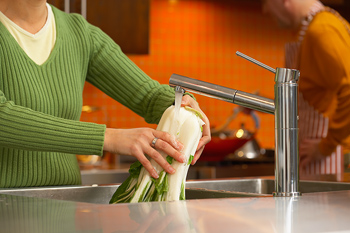Archive for the ‘Green Homes’ Category
Starting an Organic Garden

When you are looking to grow food for your family and loved ones, you already know that you want it to be healthy and nutritious, and one of the best ways to do this is to make sure that your garden is organic! Organic gardening not only allows you to grow food that is free of chemicals or additives, but it also promote ecological responsibility and has low impact consequences for the environment. If you are looking grow an organic garden, you’ll find that there are plenty of tips to get you started.
One of the best ways to get started with an organic garden is to get a hold of some heirloom seeds. You’ll find that heirloom seeds are taken from plants that were once common in human history; as such, they have not been genetically modified and as a rule, they tend to be fairly tough. They are not hybrids, and there are around 4,000 varieties of seeds, so you’ll be able to take your choice.
When working with organic gardening, you’ll find that it is always a good idea to consider the lay out of your garden. You’ll find, for instance, that you can work with intensive intercropping, where you’ll find that one crop is grown between rows of another; this will allow you to take full advantage of your gardening space, and reduce your water and composting requirements. You’ll find that gardening boxes is another way to maximize your space.
Organic gardening also implies that you will be free from the use of chemical pesticides and additives; this does not mean, however, that you are letting your garden run rampant with weeds and bugs! You’ll find that by planting some flowers and herbs around your garden, you’ll be strengthening its immunity to insects. Consider marigolds, mints and chives for a start. You’ll also find that you can deter pests by rotating your crops annually.
Any good organic garden needs a fair amount of planning, and the more you plan, the more prepared you are going to be. Take the time to consider what you can do to make sure that your organic garden continues to feed you and nourish you in the future!
Organic Care For Your Lawn!

If you are someone who has investment in your lawn looking good, you have probably seen plenty of chemical pesticides and additives that will allow your lawn to do just that, but what if you are interested in a green solution? The truth of the matter is that it is fairly simple to take care of your lawn in an organic way while sacrificing nothing when it comes to looks! When you are considering organic lawn care, start with the few basic steps listed below.
The first thing that you can do is to make sure that your mower is set as high as it should go. This should leave you with a clearance of about three to four instances. You may worry that if you cut it longer that you’ll have to mow more often, but you’ll find that this is actually completely untrue. The shorter you cut your lawn the faster it will grow; when grass is cut, it will use a lot of stored sugar to grow back, and you’ll find that this expenditure of energy will make it more vulnerable to pests.
The second thing that you can do to make sure that your lawn looks great and stays natural is to check the pH of the soil. You’ll find that there are plenty of services that will help you out with this, and this can help you head off problems before they start and give you a healthier lawn in general. If the pH is under 6.0, you can add lime, and if it is above 7.0, you can add gardener’s sulphur.
If you are looking for an all around good lawn and have plenty of time on your hands, consider the topsoil. Dig a spade into your ground at various points and find out how deep your layer of topsoil is. You’ll find that four inches is about the minimum you need for a passable lawn, while eight inches or more will give you good, strong growth above it.
Finally, remember that you should always use an organic fertilizer when your garden needs a little bit of help, especially in the fall and the spring, and that you should only water when your grass is showing some signs of drought. When you water, water deeply, and take the time to make sure that everything gets a good soaking.
As you can see, taking care of lawn can be still be eco-friendly, so see how you can get started!
Looking At Natural Pest Control For Your Organic Garden

As every gardener knows, insect pests are part and parcel of being a gardener, and that you have many different ways of dealing with them. When you are considering an organic garden, you already know that you should not use chemical pesticides, but the truth is, you really don’t need them! There are plenty of different solutions for the various pest problems that you might face, and you’ll find that with just a little bit of information under your belt that you will be able to deal with your pest problem quite easily and handily.
The first thing to keep in mind is that you can make your garden much more immune to pests simply by starting off with a good gardening structure. For instance, make sure that you rotate your plants, which will make the pests of one year completely obsolete the next. Remember that healthy soil will encourage nematodes, which will work well against soil bests, and that the use of compost and mulching can also keep pests off. Remember that plants that are native to your area will always be tougher in the face of natural pests, and that having a wide variety of plants will encourage less pests as well, due to the fact that the plants will “protect” each other.
When considering natural pest control, make it your business to encourage the natural predators of your pests. For instance, ladybugs, birds, moss, certain fungi and ground beetles are all beneficial to a garden, and you’ll find that keeping a natural garden will encourage them as well. Check at your local garden shop for any recommendations, or anything that you can do to encourage these animals and plants to help you out.
Regular garden maintenance will also help you keep the pests down. Whenever you see any small, weak or dying plants, pull them out. They may be infected, and even if they are not, they will provide a place for pests to nest. Pull the plant out and keep it from the rest of your garden. Similarly, keep your garden clear of debris, use clan mulch and weed regularly. Doing this can help with your water irrigation and keep your garden growing healthily as well.
You’ll find that natural pest control is quite easy once you learn about the pests that are troubling you. Remember that every problem has a natural solution your garden, so look around for the solutions that you need!
Sustainable Decking Solutions

Decks are a popular way to enjoy the great outdoors from the comfort of your home. Building a green deck, however, can be a challenge. That’s because deck materials are called upon to last a long time without maintenance, and do other things that resist the natural behavior of the materials. Many of the treatments that decking undergoes make it an environmental problem. Even materials that look sound might not be. Here’s some information about ecologically friendly decking to help you decide.
Wooden decking is the most popular and traditional of your options. This nontoxic material is strong for the weight, easy to work, and attractive. When managed properly, wood is a renewable resource. It’s also produced using a relatively small amount of fossil fuels. Wood is also easily recycled and bio degradable.
However, wood may break down when you least want it. Treated woods are damaging to the environment, so many people choose materials like redwood and cedar instead. Tropical hardwoods are also used, but this can be seriously damaging to rain forest environments. The further away the wood has been grown, the greater its impact on the environment. Many forests are not well managed, either.
Composite decking is another option. Made from recycled wood waste and plastic, with fiberglass, waxes, and other chemicals, this substance creates a board that’s much like wood. Some manufacturers are known for their sustainable practices and products. This material also lasts a long time without much maintenance. You should expect some warping and weathering, though. Since composite lumber looks and acts much like wood, it will also weather something like it.
There are criticisms of composite wood, too. This material is hard to dispose of once it’s worn out, since the materials it’s made up of are blended. Composite decking can’t be recycled, and is often more expensive than other materials. It’s also relatively new, and hasn’t had a chance to prove its durability.
Plastic lumber looks like a similar material, but it’s made entirely of high density polyethylene – just like milk jugs. This material is commonly recycled from waste plastic, and is workable with wood tools in the same way as composite lumber. It’s not as strong as wood or composite lumber, and is bed for posts, beams, and joists. It tends to expand and contract as temperatures change and may have a greater tendency to warp. Not all materials contain all or mostly post consumer waste, but many contain fifty percent or more.
Of course, there are plenty of non wood materials that work well for a patio or outdoor space, too. Paved patios, like those used in Mexico and the Mediterranean, are relatively non toxic, durable, and low maintenance. They also cost little, and while concrete and tile have a high initial impact, they last a very long time. An English style garden or terrace is also a good option. There’s a lot you can do with some thought and imagination that transcends the average deck. See what you can come up with!
Energy Saving Window Choices

Our homes use a lot of energy and nonrenewable resources when it comes to heating and cooling. In fact, home heat and air conditioning are some of every American’s biggest contributors to their carbon footprint. One way to cut down your costs and improve your efficiency is by installing energy saving windows. Energy efficient windows can save you money, reduce the amount of energy you’re using, and help you feel better about your personal effect on the environment.
If your home is full of attractive, traditional large windows, you might be losing all the money and savings from your energy efficient appliances, good travel habits, and good eating habits. The wrong windows can be a big source of heat transfer, causing warmth to leave your home in the winter, and enter in the summer. Fortunately, there are some things you can do to help green up your windows.
They’re the most common place for homes to loose cool air in summertime and heat in the winter, causing furnaces and air conditioners to run over time. That’s because glass is an excellent conductor. It moves energy quickly from one side of the window to the other, rather than keeping heat on the side of the wall we prefer it to be on. Sealing gaps around windows and doors can be a big help in reducing drafts, but to really prevent this kind of heat loss, you’ll either need to replace your windows or take measures to improve your old ones.
Use of blinds and drapes with insulating linings and designs properties will help you keep heat where you want it. Use retractable styles that allow you to shade your windows when desirable, and open them to the sunlight when you want warmth and light. Be sure to open and close your blinds as appropriate, so you’ll get the most benefit from them. Installing energy efficient blinds and curtains is one of the least expensive ways to change the way your home loses heat.
For those willing to take an extra step, changing out old, inefficient windows for better ones is a good option. Look for “Low-E” windows, which are double paned, and which have krypton or argon gas between those panes. These gases are invisible, but they act as an insulative layer, keeping heat where it’s supposed to be. High efficiency windows bring your home’s glass surfaces up in insulative rating, removing those holes in your home’s envelope.
If you’d like to increase your home’s efficiency and spend less on heating and cooling, more efficient windows are the answer. Seal all cracks, install appropriate blinds and curtains, and replace old, inefficient windows with higher efficiency models. You’ll soon notice a difference.
Is Your Kitchen Green?

Americans generate 15,000 pounds of carbon dioxide annually. Although a significant percentage of it comes from vehicle use, energy consumption in the kitchen is also a major culprit especially where cooking food and washing the dishes are concerned. As such, it is also imperative that alongside lessening vehicle use, you must also make your kitchen as eco-friendly as possible. In short, you need to have a “green” kitchen. And don’t fret if you cannot remodel your entire kitchen to make it eco-friendly. You can always start one little step at a time.
Water Use
We often waste water in the kitchen in the misconception that water will never run out. After all, the Earth is made up of 70 percent water. Well, you might be wrong. Water conservation is very important in homes when you consider that water is not exactly a renewable resource in the mold of the sun.
To conserve water, you can adopt these simple tips:
- Use a glass of water in brushing your teeth instead of letting it run down the drain.
- Turn the water as soon as you finish washing the fresh fruits and vegetables, meat and other food items. Also, it is important to wash food items in cold water, which will save on the energy necessary to it heat as well as save the nutrients on the fruits and vegetables that heat can kill.
- Use tap water when washing the dishes in the dishwasher. It also pays to use the dishwasher on a full load only.
Light Use
When not in use and during daylight, turn off all the lights in the kitchen. You will be surprised at how much you can save on electricity bills when you adopt this cost-saving measure. Also, try to use candles during dinner time. Not only will you create a more intimate atmosphere but you can lessen your carbon footprint on the planet.
Kitchen Countertops
Granite and quartz are very popular because of their aesthetic appeal as well as durability. However, these are not exactly eco-friendly materials when you take into account the processes involved from their mining to transporting to your home. You are better off with countertops made from recycled materials like glass from windshields, traffic lights and even beer bottles as well as newspapers and cardboards. These countertops also have aesthetic appeal and possess durability just like their granite and quartz countertops. Plus, you save money, too, since these are usually more affordable.
Kitchen Appliances
Appliances take up majority of the energy consumption in the kitchen. As such, it is necessary to start with energy-saving appliances, which is possible when said appliances have the Energy Star Label. Also, do purchase new appliances when your old appliances are conking out one time too many. Just make sure that said appliances are appropriate for the number of people using them as well as frequency of use. It is likewise important to position your appliances in strategic ways that will save on energy. For example, your refrigerator must not be placed near the oven and stove.
Your kitchen can indeed be a good start in making your whole house as green as possible. All it takes is one small step at a time, one person at a time, and one appliance at a time to achieve the goal.
Green Remodeling Principles

If you are planning to remodel your home in any way, you’ll want to ensure you do it in a way that is eco friendly. Of course, you may be a bit confused and worried you’ll make a huge mistake that is bad for the environment, who isnt? Here is a look at a few great principles that can help you figure out how you can make your remodeling projects as green as you can.
The first thing to remember is to purchase materials that are of high quality and that will end up lasting for a long time. You don’t want materials that will only last a short while or it will end up wasting more later on. In the long run you’ll benefit if you choose materials that will last a long time. When you remodel, make sure you purchase things that you want to have for the rest of your life so you don’t end up tossing the updates in the future.
Improve things instead of replacing them if it at all possible. While sometimes you’ll need to replace items, you don’t always have to do so. One example is the cabinets in your kitchen. Unless they are damaged, consider re-facing them instead of pulling them out and putting in new ones. There are many ways to restore things in the home instead of purchasing something new. You can recover pieces of furniture, restore windows, refinish tubs, and more. Not only is it better for the environment, but it’s more cost effective too. Couch covers are another cheap and great way to improve your home.
Avoid using chemicals when you are remodeling. There are many materials for home remodeling that can bring in chemicals to your home that are dangers. Consider going with items that are non toxic, such as organic carpet and insulation made of cotton fiber. Go with paints that are considered low VOC. They aren’t much more expensive than those with chemicals and they are a lot better for your health.
Make sure you have a plan to get rid of the waste when you are remodeling. While it can take some time on your part, it is definitely worth it. If possible, try to reuse those materials. Talk to contractors in your area, check with thrift stores, or even try to sell materials in a yard stale. Check with scrap yards as well to see if they’ll take older appliances and wiring. Take some time to do some research and you should be able to get rid of everything in a responsible way.
While it can take a bit more effort on your part to do a remodeling project the green way, it is worth all the effort you put into it. Doing some research and planning ahead of time can help you ensure you do everything the right way for the best effects on the environment. You may also find that there are some incentives or tax breaks that you can take advantage of if you go with products that are eco friendly as well.
Green Choices: Food Security vs. Industrial Tiger

Many developing countries today are in a dilemma over the direction to be taken in terms of development. The debate is one about choosing between becoming an industrial tiger ready to take on the industrialized nations of the world or becoming a food self-sufficient powerhouse by ensuring food security. We can name Vietnam as a good example of such a dilemma.
Shrinking Farmlands and Migrating Farmers
It is truly alarming that even in the United States, the number of farmers actually farming the land has seen significant declines in the past few years. This can be attributed to many reasons like the continued losses from negative climate conditions, the increasing use for industrial purposes of farmlands and the mounting allure of life in the city.
If this is true in the United States, a country that prides itself on food sufficiency, then it is all the more true in developing nations. Furthermore, government policy has a helping hand in it because of the political thrust towards national industrialization by a certain date.
Thus, the national and local governments will enforce laws reassigning farmlands to industrial uses. You will see rice fields behind high-rise office buildings and factories in many parts of Asia as evidence of such an industrialization policy.
All this is well and good except that food security is at stake. Keep in mind the general rule that before a developing country can progress to become a developed nation, it must be able to feed its population from its own farms and fields. Otherwise, the gains of industrialization can be offset by the costs of importation. Even the United States had a strong agricultural sector before it made its leap to becoming an industrialized nation.
And so, the dilemma begins. Food security is very important in becoming an industrial tiger but one must be sacrificed for the other and not without cost to the environment either.
Solutions in Unexpected Places
Or is it necessary to sacrifice one for the other? Well, maybe not with the innovative solutions being presented by scientists and farmers alike. For one thing, the option of seed hybridization is available. Basically, two crop varieties of the same produce are cross breed to eliminate their negative qualities and highlight the positive properties. As a result, a better variety of crops is produced, be it for rice, wheat or potatoes.
For another thing, there is nuclear energy. Fortunately, we are not referring to the nuclear energy of Hiroshima and Nagasaki as we know it. This time, nuclear energy is used in a process called mutation induction where the crops specifically rice are bombarded with radiation. In turn, a variety of genetic mutations result in new varieties that are chosen for their specific properties like height of stalks, size of seeds and length of germination.
These methods of selective breeding of crops also have their environmental impacts, of course. But with the right balance between ensuring food security while giving way to the advances of industrialization, we have hope that developing nations will not fall into the negative effects of the march towards industry without regard for agriculture.
3 Organic Methods to a Great Smelling Home
 Most people find that their home doesn’t always smell the best. There are some foods that leave a smell or others can smell bad if they accidentally get burned while being cooked. Then there are some “experiments” that accidentally get created inside the fridge, which can really leave a foul odor as well. Of course, while you may want to eliminate those nasty odors, you won’t want to bring in the poisons that can come along with air fresheners that are synthetic and full of chemicals. Here is a look at some organic methods you can use to get a home that smells great.
Most people find that their home doesn’t always smell the best. There are some foods that leave a smell or others can smell bad if they accidentally get burned while being cooked. Then there are some “experiments” that accidentally get created inside the fridge, which can really leave a foul odor as well. Of course, while you may want to eliminate those nasty odors, you won’t want to bring in the poisons that can come along with air fresheners that are synthetic and full of chemicals. Here is a look at some organic methods you can use to get a home that smells great.
Get Rid of the Odor
First, you need to work at getting rid of the source of the odors that are in your home. You can’t afford to merely cover up those odors. If there are veggies and fruits that are rotting, throw them in the compost bucket. Wash away any leftover trace that may be in the fridge as well. Use some baking soda in the fridge to eliminate the odors that show up there. Another way is to empty your garbage and if there is any wetness in the can, it needs to be washed up. Then to get rid of odors, put in a bit of baking soda. Did you accidentally burn dinner? Suck out the smoke with the hood on the range and then use a towel dampened with some vinegar, wave it around, and try to stop the alarm while still neutralizing any smells in the air.
Add Nice Smells
The next thing that you need to do to get a home that smells nice is to add some nice smells to your home. While you are cooking foods that smell strong, such as cabbage and fish, a bit of warm vinegar on the stove can help to eliminate these smells. Another option you have is to burn some candles and they should be unscented. Just make sure that any candles you light are kept away from pets and kids. Spraying around some vinegar and water can help get rid of strong odors from cooking too. Take a spray bottle, put in an equal amount of water and vinegar, then spray into the air. A little vanilla extract can help with smells as well. Put a bit on a cotton ball, then put that on a saucer, and simply allow it to sit on the counter. Heating up some cinnamon sticks on the stove in some warm water and leave a pleasant smell as well. You can add in some lemons and cloves for an even better smell.
Clean Air from Plants
Having some plants is a great idea if you want to eliminate smells from your home. They can provide you with some more clean air. When they produce the oxygen, they help to get rid of toxins that are in the air, leaving you with cleaner air that smells better. Plants that have leaves that are scented can also help the air, such as lavender, rosemary, geraniums, and more.
Best Green Home – Find Out How To Get The Best Green Home
Are you looking for the best green home possible? Now I know just a little research makes finding the best way to build the best green home seem pretty intimidating. I have spent lots of time doing research on building the best possible green home. Doing research can be very tedious because it’s hard to find the most important things that go into the best green home. Don’t want to read this article check out my best green home review site here.
There are several things involved in building the best green. You want to think about how you’re going to power your home. The best green homes are powered using solar and wind turbines. I know what you’re thinking when you hear solar panels and wind turbines they cost way too much and they’re way too complicated. I know why you’re thinking this because I used to think the very same way. Then I learned that I could actually build my very own solar panels and wind turbines for under $200 with little experience. I couldn’t believe this and I soon realized that having the best green home could be a reality. I learned that all I needed was the right teacher and my dream of having the best green home could become a reality.
So guess what I did, I started looking for the best program for building your own solar panels and wind turbines. After starting my research I realized that there were so many programs out there I didn’t know where to start. Jumping forward several months, I finally found the best programs on the internet for building the best green home. I found a few that weren’t so good either. I was so satisfied to finally find several good programs that I wanted to share my success with the world. That way no one else would ever have to go through all the trouble I did to find the best green home programs.
This is what led me to publish my best green home review site. My goal in publishing this site is to share my knowledge with the world so no one will ever have to do all the research I did to build my own solar panels and wind turbines. I choose all the products I review on the site from my own experience with each of them. When I made the site it was also very important to me that I reviewed some products that I didn’t like so people would be warned against scams and have the best experience possible building their own green home.
So if you’re trying to make the best green home possible I highly suggest that you check out my website if you haven’t already. I promise you will not be disappointed. So what do you have to loose learn how to build your own green home right now just click on the link.
Fetch helpful things to know in the sphere of traffic to website – please go through this web page. The times have come when proper information is really within your reach, use this opportunity.



